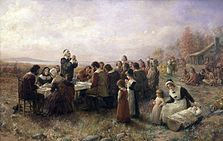Happy Thanksgiving From Larrondo Dentistry!
 Thanksgiving comes to us out of prehistoric dimness, universal to all ages and faiths. At whatever straws we may grasp, there is always a new time for gratitude and new beginnings. – J. Robert Moskin
Thanksgiving comes to us out of prehistoric dimness, universal to all ages and faiths. At whatever straws we may grasp, there is always a new time for gratitude and new beginnings. – J. Robert Moskin
Thanksgiving Through The Years!
This year during the holiday season I’ve decided to do some research and find out a bit about the history of the major holidays. I ‘ll start with Thanksgiving and continue it through Christmas. Since most of us know the story of our American Thanksgiving I decided to take a look at what they have done in other cultures both past and present. (With a brief review of where our Thanksgiving came from just to refresh your memory!)
Before the establishment of formal religions many ancient farmers believed that their crops contained spirits which caused the crops to grow and die. Many believed that these spirits would be released when the crops were harvested and they had to be destroyed or they would take revenge on the farmers who harvested them. Some of the harvest festivals celebrated the defeat of these spirits.
Harvest festivals and thanksgiving celebrations were held by the ancient Greeks, the Romans, the Hebrews, the Chinese, and the Egyptians.
The Greeks: The ancient Greeks worshiped many gods and goddesses. Their goddess of corn (actually all grains) was Demeter who was honored at the festival of Thesmosphoria held each autumn. On the first day of the festival married women (possibility connecting childbearing and the raising of crops) would build leafy shelters and furnish them with couches made with plants. On the second day they fasted. On the third day a feast was held and offerings to the goddess Demeter were made – gifts of seed corn, cakes, fruit, and pigs. It was hoped that Demeter’s gratitude would grant them a good harvest.
The Romans: The Romans also celebrated a harvest festival called Cerelia, which honored Ceres their goddess of corn (from which the word cereal comes). The festival was held each year on October 4th and offerings of the first fruits of the harvest and pigs were offered to Ceres. Their celebration included music, parades, games and sports and a thanksgiving feast.
The Chinese: The ancient Chinese celebrated their harvest festival, Chung Ch’ui, with the full moon that fell on the 15th day of the 8th month. This day was considered the birthday of the moon and special “moon cakes”, round and yellow like the moon, would be baked. Each cake was stamped with the picture of a rabbit – as it was a rabbit, not a man, which the Chinese saw on the face of the moon.
The families ate a thanksgiving meal and feasted on roasted pig, harvested fruits and the “moon cakes”. It was believed that during the 3 day festival flowers would fall from the moon and those who saw them would be rewarded with good fortune. According to legend Chung Ch’ui also gave thanks for another special occasion. China had been conquered by enemy armies who took control of the Chinese homes and food. The Chinese found themselves homeless and with no food. Many starved. In order to free themselves they decided to attack the invaders.
The women baked special moon cakes which were distributed to every family. In each cake was a secret message which contained the time for the attack. When the time came the invaders were surprised and easily defeated. Every year moon cakes are eaten in memory of this victory.
The Hebrews: Jewish families also celebrate a harvest festival called Sukkoth. Taking place each autumn, Sukkoth has been celebrated for over 3000 years. Sukkoth begins on the 15th day of the Hebrew month of Tishri, 5 days after Yom Kippur the most solemn day of the Jewish year.
Sukkoth is named for the huts (succots) that Moses and the Israelites lived in as they wandered the desert for 40 years before they reached the Promised Land. These huts were made of branches and were easy to assemble, take apart, and carry as the Israelites wandered through the desert.
When celebrating Sukkoth, which lasts for 8 days, the Jewish people build small huts of branches which recall the tabernacles of their ancestors. These huts are constructed as temporary shelters, as the branches are not driven into the ground and the roof is covered with foliage which is spaced to let the light in. Inside the huts are hung fruits and vegetables, including apples, grapes, corn, and pomegranates. On the first 2 nights of Sukkoth the families eat their meals in the huts under the evening sky.
The Egyptians: The ancient Egyptians celebrated their harvest festival in honor of Min, their god of vegetation and fertility. The festival was held in the springtime, the Egyptian’s harvest season. The festival of Min featured a parade in which the Pharaoh took part. After the parade a great feast was held. Music, dancing, and sports were also part of the celebration.
When the Egyptian farmers harvested their corn, they wept and pretended to be grief-stricken. This was to deceive the spirit which they believed lived in the corn. They feared the spirit would become angry when the farmers cut down the corn where it lived.
The United States: In 1621, after a hard and devastating first year in the New World the Pilgrim’s fall harvest was very successful and plentiful. There was corn, fruits, vegetables, along with fish which was packed in salt, and meat that was smoke cured over fires. They found they had enough food to put away for the winter. The Pilgrims had beaten the odds. They built homes in the wilderness, they raised enough crops to keep them alive during the long coming winter, and they were at peace with their Indian neighbors. Their Governor, William Bradford, proclaimed a day of thanksgiving that was to be shared by all the colonists and the neighboring Native American Indians.
The custom of an annually celebrated thanksgiving, held after the harvest, continued through the years. During the American Revolution (late 1770’s) a day of national thanksgiving was suggested by the Continental Congress. In 1817 New York State adopted Thanksgiving Day as an annual custom. By the middle of the 19th century many other states also celebrated a Thanksgiving Day. In 1863 President Abraham Lincoln appointed a national day of thanksgiving. Since then each president has issued a Thanksgiving Day proclamation, usually designating the fourth Thursday of each November as the holiday.
Next month interesting facts about Christmas! (And maybe another recipe challenge!)
THE ONLY WAY TO COOK A TURKEY!
This turkey is work… it requires more attention than an average six-month-old baby. There are no shortcuts, as you will see. It’s challenge, hopefully some of you are up to it. If you cook it let me know!
Get a HUGE turkey– I don’t mean just a big, big bird, but one that looks as though it gave the farmer a hard time when he did it in. It ought to weigh between 16 and 30 pounds. Have them remove the neck close to the body, leaving the tube. You will want this for stuffing. Also, he should leave all the fat on the bird.
When you are ready to cook your bird, rub it inside and out with salt and pepper. Give it a friendly pat and set it aside. Chop the heart, gizzard, and liver and put them, with the neck, into a sauce pan with a clove of garlic, a large bay leaf, 1/2 tsp coriander, and some salt. I don’t know how much salt– whatever you think. Cover this with about 5 cups of water and put on the stove to simmer. This will be the basting fluid a little later.
Get a huge bowl. Throw into it one diced apple, one diced orange, a large can of crushed pineapple, the grated rind of a lemon, and three tablespoons of chopped preserved ginger (If you like ginger, double). Add 2 cans of drained Chinese water chestnuts.
Mix this altogether. Get a second, somewhat smaller, bowl. Into this, measuring by teaspoons, put:
2 tsp hot dry mustard
2 tsp caraway seed
2 tsp celery seed
2 tsp poppy seed
1 tsp black pepper
2 1/2 tsp oregano
1/2 tsp mace
1/2 tsp turmeric
1/2 tsp marjoram
1/2 tsp savory
3/4 tsp sage
3/4 tsp thyme
1/4 tsp basil
1/2 tsp chili powder
In the same bowl, add:
1 tbsp poultry seasoning
4 tbsp parsley
1 tbsp salt
4 headless crushed cloves
1 well-crushed bay leaf
4 lrg onions
6 good dashes Tabasco
5 crushed garlic cloves
6 lrg chopped celery
Wipe your brow, refocus your eyes, and get a third bowl. Put in three packages of unseasoned bread crumbs (or two loaves of toast or bread crumbs), 3/4 lb. ground veal, 1/2 lb. ground fresh pork, 1/4 lb. butter, and all the fat you have been able to pull out of the bird.
Get a fourth bowl, an enormous one. Wash your hands, and mix the contents of all the other bowls. Mix it well. Stuff the bird and skewer it. Put the leftover stuffing into the neck tube.
Turn your oven to 500 degrees F and get out a fifth small bowl. Make a paste consisting of four egg yolks and lemon juice. Add 1 tsp hot dry mustard, a crushed clove of garlic, 1 Tbsp onion juice, and enough flour to make a stiff paste. When the oven is red hot, put the bird in, breast down on the rack. Sip on your drink until the bird has begun to brown all over, then take it out and paint the bird all over with paste. Put it back in and turn the oven down to 350 degrees F. Let the paste set, then pull the bird out and paint again. Keep doing this until the paste is used up.
Add a quart of cider or white wine to the stuff that’s been simmering on the stove, This is your basting fluid. The turkey must be basted every 15 minutes. Don’t argue. Set your timer and keep it up. (When confronted with the choice “do I baste from the juice under the bird or do I baste with the juice from the pot on the stove?” make certain that the juice under the bird neither dries out and burns, nor becomes so thin that gravy is weak. When you run out of baste, use cheap red wine. This critter makes incredible gravy! The bird should cook about 12 minutes per pound, basting every 15 minutes. Enlist the aid of your friends and family. )
As the bird cooks, it will first get a light brown, then a dark brown, then darker and darker. After about 2 hours you will think I’m crazy. The bird will be turning black. (Newcomers to black turkey will think you are demented). In fact, by the time it is finished, it will look as though we have ruined it. Take a fork and poke at the black cindery crust.
Beneath, the bird will be a gorgeous mahogany, reminding one of those golden-browns found in precious Rembrandts. Stick the fork too deep, and the juice will gush to the ceiling. When you take it out, ready to carve it, you will find that you do not need a knife. A load sound will cause the bird to fall apart like the walls of that famed biblical city. The moist flesh will drive you crazy, and the stuffing–well, there is nothing like it on this earth. You will make the gravy just like it is always done, adding the giblets and what is left of the basting fluid.
Sometime during the meal, use a moment to give thanks to Morton Thompson (the originator of the recipe). There is seldom, if ever, leftover turkey when this recipe is used. If there is, you’ll find that the fowl retains its moisture for a few days. That’s all there is to it. It’s work, hard work— but it’s worth it.
Wishing a Happy Thanksgiving from all of us at Larrondo Dentistry to all of you!
Dr. Jorge E. Larrondo and Staff
Larrondo Dentistry is located at 160 S. Santa Fe. Street, Hemet, California. Office telephone is 951-925-6596.


